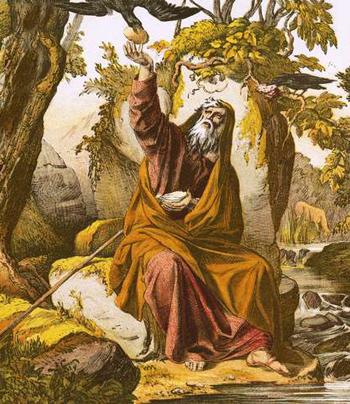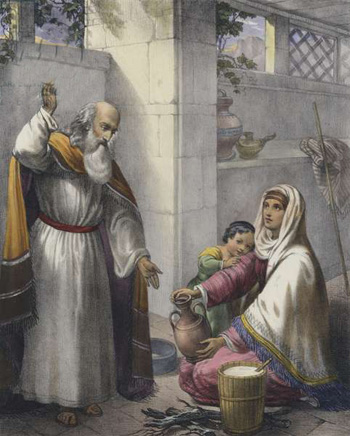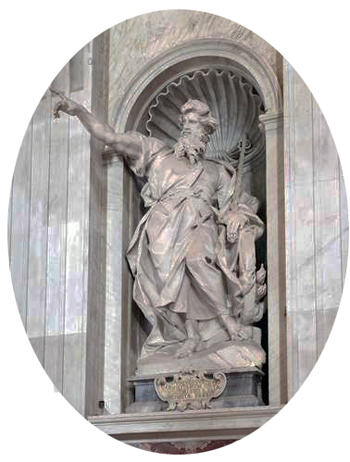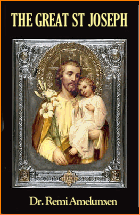Symbolism
 |
 |
 |
 |
 |
 |
 |
The Symbolism of the Thesbite Woman
The Epistle of the second week of Lent for Tuesday relates the story of Elias meeting the widow woman and her son. God Our Lord had told Elias there would be no rain or dew in Israel for three years. On His order, Elias went to a place with a creek called Wadi Cherith, where ravens brought food to him morning and night.
 When the creek ran dry, Our Lord told Elias to go and dwell is Saraphta where the Sidonian Gentiles lived. This is where the Epistle begins: He meets a widow gathering sticks, and he asked her for water and a crust of bread. She replies that she is a widow and has only enough food and drink for her and her son to have one small meal before they shall die.
When the creek ran dry, Our Lord told Elias to go and dwell is Saraphta where the Sidonian Gentiles lived. This is where the Epistle begins: He meets a widow gathering sticks, and he asked her for water and a crust of bread. She replies that she is a widow and has only enough food and drink for her and her son to have one small meal before they shall die.
Elias told the woman she and her son would not die of starvation. She believed him and took him in, and her small pot of meal and cruse of oil did not diminish throughout those days of famine and drought.
In his Liturgical Year, Dom Guéranger tells us that Elias, who is our faithful companion in the liturgy during Lent, is represented in this Epistle as a foreshadowing of the treatment that God will one day show to His ungrateful people as well as the future role of the Gentiles.
Meeting the widow
When Elias went in search of food, it would be a great privilege for a Jew to entertain the Prophet, for God is with him.
But where did he go? To a family in the Kingdom of Israel? Or into the land of Judah? No, for the people had continued obstinate in their sins and oblivious to God's words.
So Elias directed his steps toward the land of the Gentiles, entering the country of Sidon. Coming to the gates of a city called Saraphta, he saw a poor widow. It is to her that he transferred the blessing that Israel had rejected.
 Luke clearly presents the picture: "In truth I say to you, there were many widows in the days of Elias in Israel, and to none of them was he sent, but to Saraphta of Sidon, to a widow woman." (Lk 4:25-26)
Luke clearly presents the picture: "In truth I say to you, there were many widows in the days of Elias in Israel, and to none of them was he sent, but to Saraphta of Sidon, to a widow woman." (Lk 4:25-26)
So, then, this poor woman is a figure of the Gentiles who were called to the Faith. The woman is a widow; she has no one to defend or protect her. Thus she represents the Gentiles, who were abandoned by all and had no one who could save them from the enemy of mankind.
All the mother and her child have to live on is a handful of meal and a little oil: It is an image of the frightful dearth of truth in which the pagans were living at the time when the Gospel was preached to them.
Notwithstanding her extreme poverty, the widow of Saraphta received the Prophet with kindness and confidence. She believed what he told her, and she and her son were saved. It is thus that the Gentiles welcomed the Apostles when these shook the dust from their feet and left the faithless Jerusalem.
When Elias came upon the woman, she was holding two pieces of wood in her hands? What is their significance?
St. Augustine, St. Caesarius of Arles and St. Isidore of Seville tell us that this wood is a figure of the Cross. With this wood the widow bakes the bread that is to support her. It is from the Cross that the Gentiles receive life by Jesus Christ, Who is the living Bread.
While Israel dies of famine and drought, the Gentile Church feeds abundantly on the heavenly wheat and on the oil, which is the symbol of strength and charity.
Dom Guéranger ends with strong words that are especially pertinent for our times: He warns us of the danger of rejecting the gift of the Faith and the Holy Church:
"Glory be to Him who has called us out of darkness into His marvelous light of faith! But let us tremble at witnessing the evils that the abuse of grace brought upon a whole people. God in His justice did not spare a whole nation that he called His Chosen People, but cast it off. Will, then, He spare you or me if we dare to resist His call?"


Adapted from Dom Gueranger,
The Liturgical Year, Vol. 5, pp 207-209
Posted March 24, 2021

A raven brings Elias his daily bread
Elias told the woman she and her son would not die of starvation. She believed him and took him in, and her small pot of meal and cruse of oil did not diminish throughout those days of famine and drought.
In his Liturgical Year, Dom Guéranger tells us that Elias, who is our faithful companion in the liturgy during Lent, is represented in this Epistle as a foreshadowing of the treatment that God will one day show to His ungrateful people as well as the future role of the Gentiles.
Meeting the widow
When Elias went in search of food, it would be a great privilege for a Jew to entertain the Prophet, for God is with him.
But where did he go? To a family in the Kingdom of Israel? Or into the land of Judah? No, for the people had continued obstinate in their sins and oblivious to God's words.
So Elias directed his steps toward the land of the Gentiles, entering the country of Sidon. Coming to the gates of a city called Saraphta, he saw a poor widow. It is to her that he transferred the blessing that Israel had rejected.

Elias meets the widow of Saraphta
So, then, this poor woman is a figure of the Gentiles who were called to the Faith. The woman is a widow; she has no one to defend or protect her. Thus she represents the Gentiles, who were abandoned by all and had no one who could save them from the enemy of mankind.
All the mother and her child have to live on is a handful of meal and a little oil: It is an image of the frightful dearth of truth in which the pagans were living at the time when the Gospel was preached to them.
Notwithstanding her extreme poverty, the widow of Saraphta received the Prophet with kindness and confidence. She believed what he told her, and she and her son were saved. It is thus that the Gentiles welcomed the Apostles when these shook the dust from their feet and left the faithless Jerusalem.
When Elias came upon the woman, she was holding two pieces of wood in her hands? What is their significance?
St. Augustine, St. Caesarius of Arles and St. Isidore of Seville tell us that this wood is a figure of the Cross. With this wood the widow bakes the bread that is to support her. It is from the Cross that the Gentiles receive life by Jesus Christ, Who is the living Bread.
While Israel dies of famine and drought, the Gentile Church feeds abundantly on the heavenly wheat and on the oil, which is the symbol of strength and charity.
Dom Guéranger ends with strong words that are especially pertinent for our times: He warns us of the danger of rejecting the gift of the Faith and the Holy Church:
"Glory be to Him who has called us out of darkness into His marvelous light of faith! But let us tremble at witnessing the evils that the abuse of grace brought upon a whole people. God in His justice did not spare a whole nation that he called His Chosen People, but cast it off. Will, then, He spare you or me if we dare to resist His call?"

Elias the Prophet at St. Peter's Basilica

Adapted from Dom Gueranger,
The Liturgical Year, Vol. 5, pp 207-209
Posted March 24, 2021
______________________
______________________











